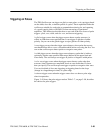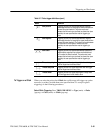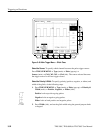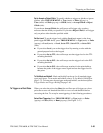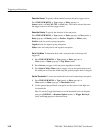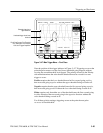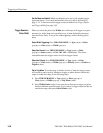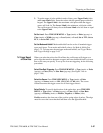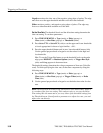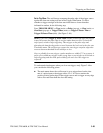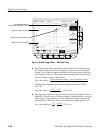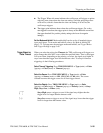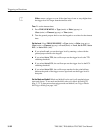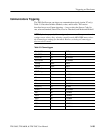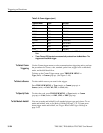
Triggering on Waveforms
TDS 500C, TDS 600B, & TDS 700C User Manual
3–97
3. To set the range of pulse widths in units of time, press Upper Limit (side)
and Lower Limit (side). Enter the values with the general purpose knob or
keypad. The Upper Limit is the maximum valid pulse width the trigger
source will look for. The Lower Limit is the minimum valid pulse width.
The oscilloscope will always force the Lower Limit to be less than or equal
to the Upper Limit.
Set the Level . Press TRIGGER MENU ➞ Type (main) ➞ Pulse (pop-up) ➞
Class (main) ➞ Width (pop-up) ➞ Level (main) ➞ Level, Set to TTL, Set to
ECL, or Set to 50% (side).
Set the Mode and Holdoff. Mode and holdoff can be set for all standard trigger
types and classes. To set mode and holdoff, refer to Set Mode & Holdoff on
page 3–75. To learn more about trigger mode and holdoff, see Trigger Modes
and Trigger Holdoff on page 3–65.
When you select the pulse class Slew Rate, the oscilloscope will trigger on a
pulse edge that traverses between an upper and lower threshold faster or slower
than a slew rate you specify. To set up for slew rate triggering, do the following
procedures.
Select Slew Rate Triggering. Press TRIGGER MENU ➞ Type (main) ➞ Pulse
(pop-up) ➞ Class (main) ➞ Slew Rate (pop-up). (See Figure 3–48 on
page 3–100.)
Select the Source. Press TRIGGER MENU ➞ Type (main) ➞ Pulse
(pop-up) ➞ Source (main) ➞ Ch1, Ch2, Ch3, or Ch4 (side). The source
selected becomes the trigger source for all four trigger classes.
Select Polarity. To specify the direction of the pulse edge, press TRIGGER
MENU ➞ Type (main) ➞ Pulse (pop-up) ➞ Class (main) ➞ Slew Rate
(pop-up) ➞ Polarity (main) ➞ Positive, Negative, or Either (side).
Positive monitors the slew rate of the positive-going edges of pulses. The edge
must first cross the lower threshold and then cross the upper threshold.
To Trigger Based
on Slew Rate



